About Futuro San Antonio
Futuro San Antonio amplifies family voices to drive advocacy and policy solutions that create high-quality educational opportunities for every student in our city because decisions about schools should be shaped with families, not around them.
We are a San Antonio-based research-action organization that convenes education and political leaders and mobilizes students and families to advocate for data-driven policy solutions that ensure public education access, quality, and accountability.

Executive Summary
Futuro San Antonio led a seven-week project to hear from families across the city about their experiences with local schools.
Our team went into every City Council district to listen through door-to-door conversations, online surveys, and public tabling events. We spoke with over 14,000 households and reached more than 250,000 people online.
Families tell a consistent story: they feel good about their own child’s school but are cooler on the system overall.
The average satisfaction score for a child’s school was 7.1 out of 10. The citywide score was lower, at 6.05. The biggest issue on people’s minds was helping students learn to read and write better. Other important topics were student mental health, supporting teachers, and helping students come to school more often.
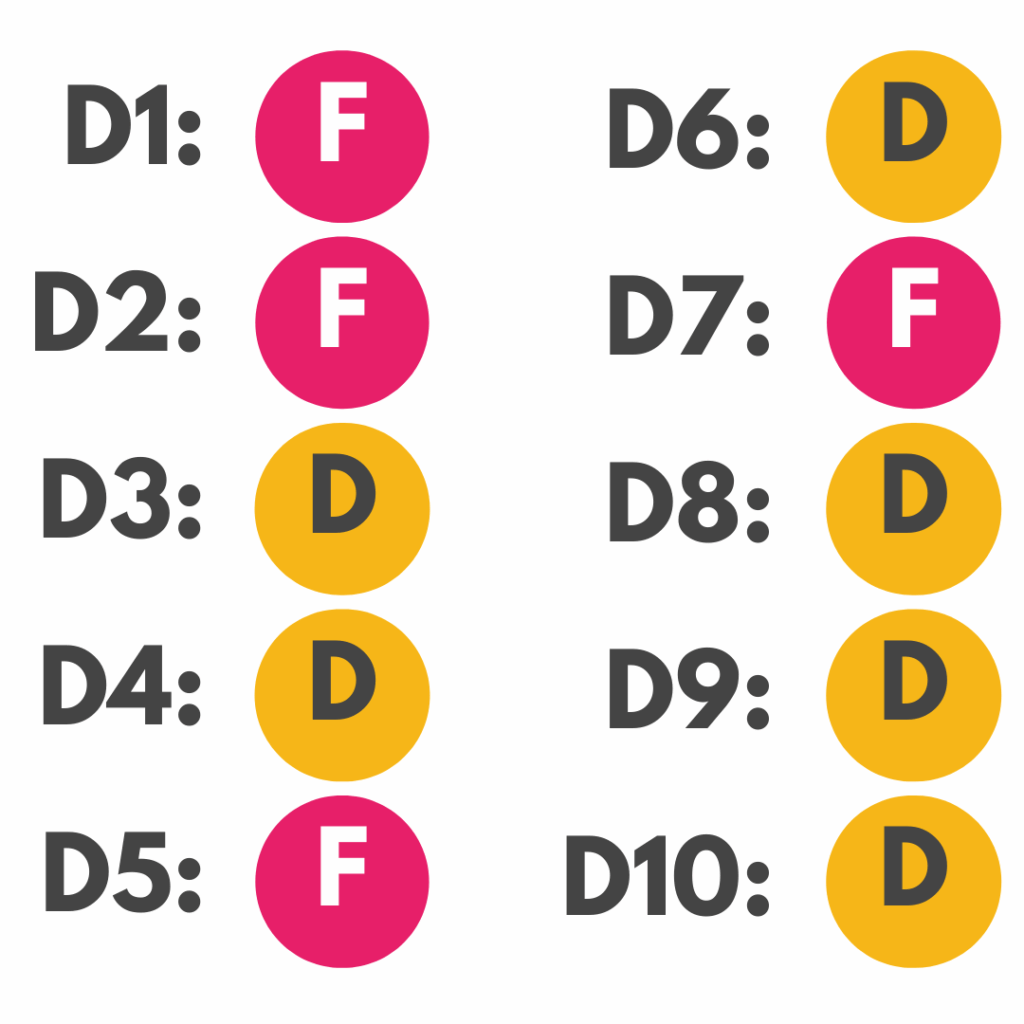
About
This Campaign
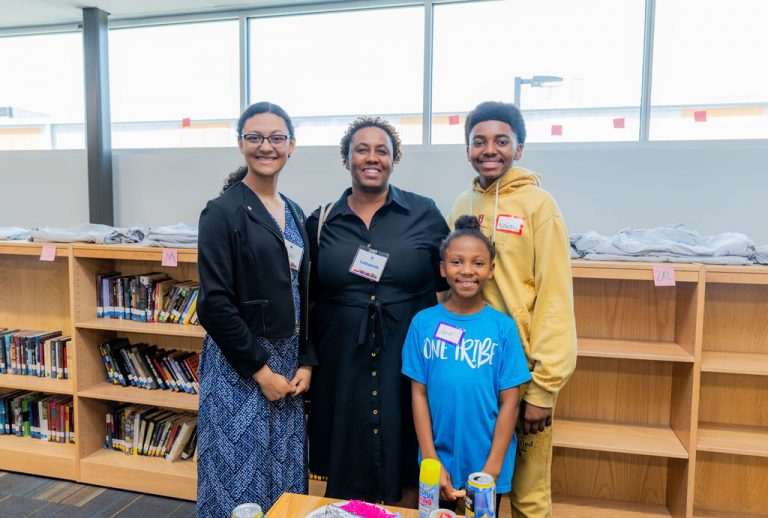
Who Led This Work?
Futuro San Antonio is a group of parents, educators, and community members working to improve schools. They want every child to have access to a good public school—whether it’s a regular or charter school. Fifteen trained team members, including parents, went out into the community to collect honest thoughts from families.
What is Deep Canvassing?
Deep canvassing is a research-backed method of community engagement that emphasizes relational, story-based dialogue as a means of persuasion and perspective-shifting.
What We Talked About
The survey asked families how they feel about San Antonio’s public schools. We focused on whether schools are fair and good for all kids, especially Latino, Black, and low-income students. Families talked about both the good parts and the problems they see in the system.
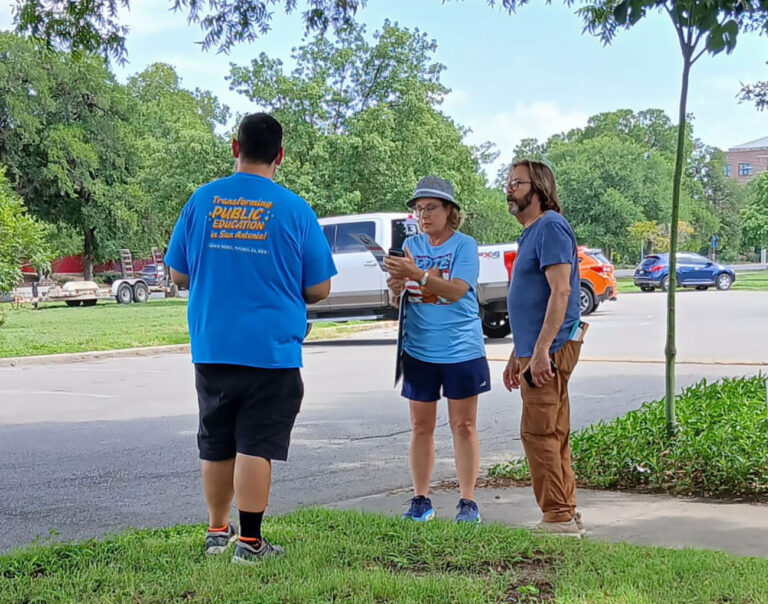

Where We Canvassed
We spoke to families in all 10 City Council districts and every ZIP code within San Antonio. We reached families in regular public schools and public charter schools. This helped us hear from a wide range of people in different neighborhoods.
Canvassing Timeline
Over seven weeks, we talked to families in every neighborhood. We knocked on doors, shared a digital survey online, and spoke to voters at polling places. This helped us reach families from many backgrounds, including those who may not always get asked what they think.
Demographics
Most of the people who answered the survey were parents or caregivers of children in K–12 schools. The average age of respondents was 45 years old. More than half identified as Hispanic, followed by White, Black, and Asian respondents. Most people who answered the survey were women, which reflects the strong role that mothers and female caregivers play in their children’s education
Issues encountered with canvassing effort
Canvassers faced some big challenges. Some people didn’t want to talk because of fear around immigration, feeling tired of politics, or not trusting strangers at the door. People were worried about privacy and didn’t always feel safe sharing their opinions.
Race:
Gender representation:

Survey
Findings
Question
#2
On a scale of 1 to 10, how satisfied are you with your child’s education?
(1 = not at all, 10 = very satisfied)
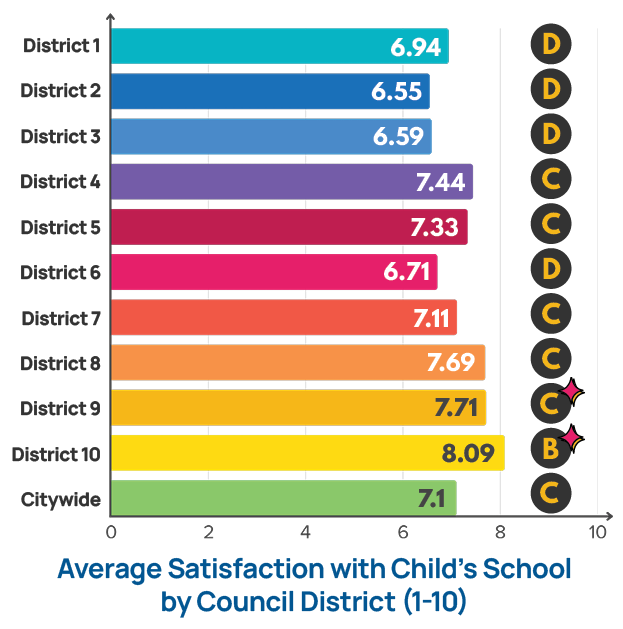
Understanding the Data
How did each city council district rank the issue?
Families were asked to rate their child’s school from 1 to 10. The average score across the city was 7.1. Districts 8, 9, and 10 had the highest ratings, while Districts 2 and 3 had the lowest. This shows that where a family lives can affect how they feel about their child’s school.
Relationship of demographics and how issues were ranked
White and Hispanic families gave the highest scores, while Black and Asian families gave slightly lower ones. Men rated schools higher than women. This shows people’s experiences can be different based on who they are and how involved they are with schools.
Layering Data
City Education Partners Year Impact Report: 3rd-8th grade STAAR Test
In San Antonio, only 48 percent of students read at grade level and 33 percent meet grade level in math. Still, many parents feel good about their schools because they trust the teachers and feel their kids are cared for.
But school quality is not the same across the city. Districts 9, 8, and 10 have the strongest results, while Districts 5, 3, and 2 have the weakest. Charter schools and in-district charter schools often do better than other schools, especially for students from families with less money.
To make things more equitable, we need better data, more support, and a stronger voice from families and the community.
Average Proficiency by
City Council District*
*Year Impact Report: 3rd-8th grade STAAR Test. City Education Partners, 2025
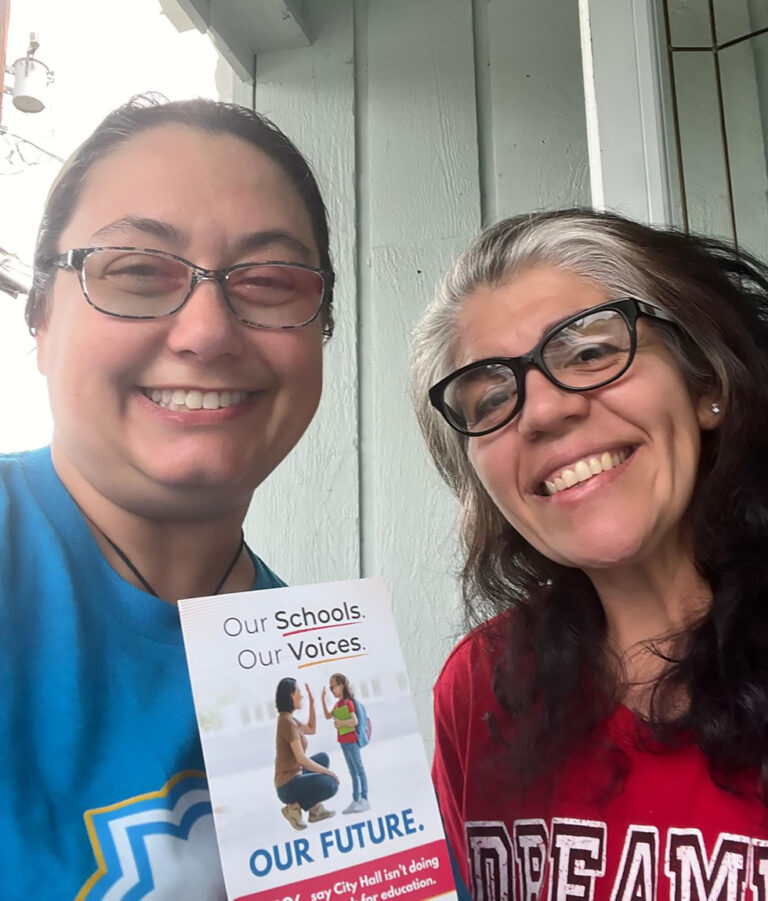
“My child’s school is warm and welcoming. She receives the attention she needs and she gets to learn from and about a diverse peer group., The main issue in our city is that the state has been consistently underfunding our schools while adding more and more unpaid duties to our school staff and additional stress from state testing. In general our schools are very good.”
District 1 Resident
“Since starting school, my kids have been a lot happier, and more social, which are things that they were struggling with. Of course they are learning to read and write as they are in elementary, but the school has welcomed them and is getting them started for the right path to keep going up until high school. In certain areas, the education and school systems are better versus the less richer areas. It’s unfair in a sense, but it does all come down to public funding.”
District 4 Resident
Survey
Findings
Question
#3
On a scale of 1-10, how would you rate the overall quality of education in San Antonio?
(1 = very bad, 10 = excellent)
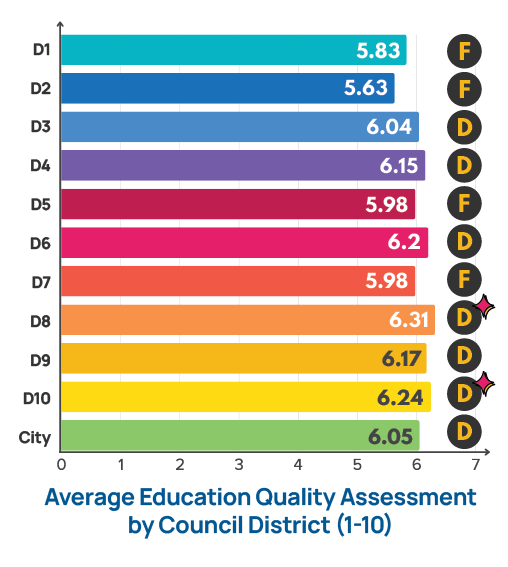
Understanding the Data
How did each city council district rank the issue?
The citywide average score was 6.05, reflecting a moderately positive assessment of the educational landscape. This indicates that while many families recognize strengths in the system, there is still significant room for growth and improvement.
Respondents consistently rated the quality of their own child’s education higher than the overall quality of education in San Antonio.
Parents gave San Antonio schools an average score of 6.05 out of 10, which was lower than the score they gave their own child’s school. This trust gap shows that families believe in their local school but are less confident in the system overall. To close the gap, the city will need more support for struggling schools and fairer changes across the system.
Quality of Education in SA Overall
vs in Their Schools
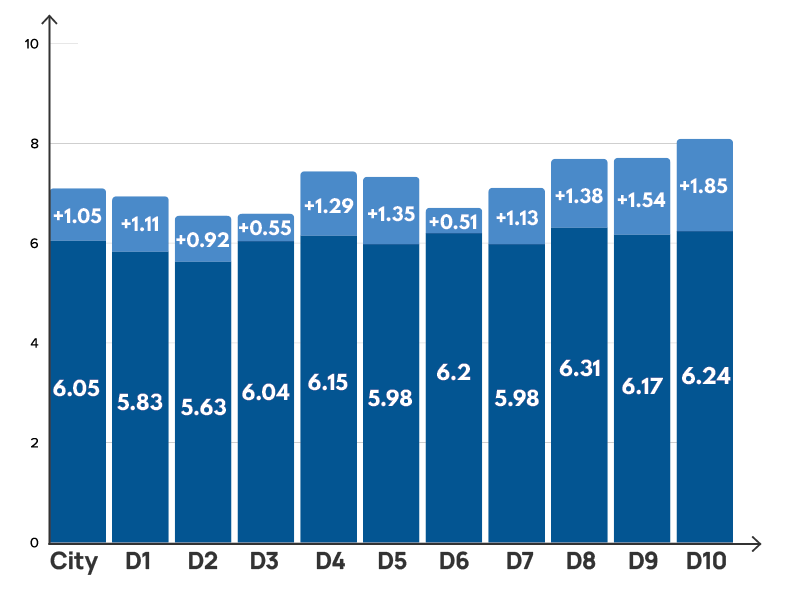
Average Satisfaction Scores
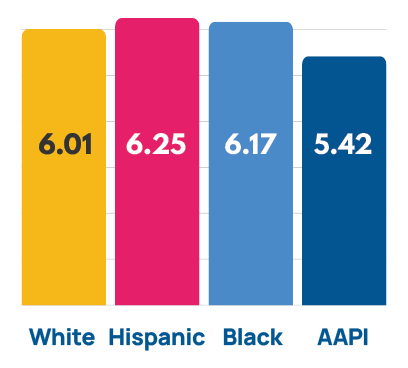
Demographics
Relationship of demographics and how issues were ranked
All racial and gender groups rated their own child’s school higher than the citywide school system, showing a clear trust gap. This was strongest among Asian and White families, who trusted their local schools but worried more about fairness across the system. The results point to the need for more support in neighborhoods and bigger changes to improve equity citywide.
Survey
Findings
Question
#4
People in San Antonio have said these four problems in schools matter most.
Can you rank them from most to least important to you?
Priority Issues: Ranked
Understanding the Data
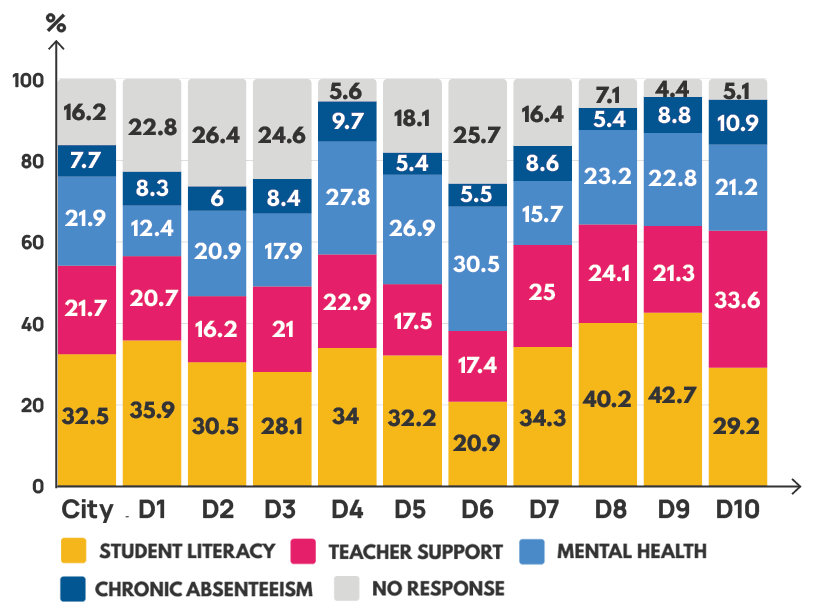
How did each city council district rank the issue?
When asked about the biggest problems in schools, most families chose student literacy as the top concern, followed by mental health and teacher support. Fewer families chose absenteeism, but the priorities shifted in different parts of the city, with District 9 focusing most on literacy while Districts 6 and 10 placed more importance on mental health and teacher support.
Relationship of demographics and how issues were ranked
Most families across San Antonio said student literacy was the top priority for schools. Black families, however, ranked teacher support as most important, showing concern for the conditions teachers face and how that affects students.
About
The Issues
Student Literacy
San Antonio faces significant literacy challenges: recent data shows only about 48 percent of students scored at or above grade level in reading during the 2023–24 school year, with little improvement over time. Adult literacy rates remain low, with an estimated 25 percent of adults either functionally or fully illiterate.
or above grade level
I believe that reading and writing are the core part of education, building their foundation on this. Having more opportunities for the kids to learn this skill in different capacities is crucial. They should be allowed to journal outside in the morning or afternoons not just inside a classroom at the same time everyday.”
– Resident of District 7
health referrals
Mental Health
In South San, Edgewood, and Harlandale ISDs, referrals for mental health services rose by 157 percent between fall 2020 and fall 2021, with anxiety, stress, and grief being the most reported issues. San Antonio ISD averages one counselor per 437 students. This is well above recommended levels and limiting access to support services.
I picked mental health because I’ve seen firsthand how much pressure kids are under these days; social media, academic stress, family issues. If a student isn’t in a good place mentally and emotionally, it’s incredibly hard for them to focus and learn. We need more school counselors and psychologists, not just for crisis intervention but for proactive support. Regular check-ins, mental health education integrated into the curriculum, and easy access to community resources would be huge. It’s about supporting the whole child, not just their academic performance
– Resident of District 8
Teacher Support
Teacher shortages persist in San Antonio with high vacancy rates, especially in special education and bilingual roles. A statewide survey finds that 66 percent of teachers report feeling overworked, and three‑quarters feel undervalued. All are factors contributing to poor retention and morale.
undervalued
I believe supporting teachers is foundational to addressing all other issues. If teachers are overworked, underpaid, and lack adequate support, it directly impacts their ability to effectively teach and address student needs. We need to see increased teacher salaries, robust mentorship programs for new educators, and better administrative support for managing classroom challenges, including student behavior. Investing in “Grow Your Own” programs and teacher residency initiatives could also help build a stronger, more stable teaching workforce. A respected and well-supported teaching profession is essential for quality education.”
– Resident of District 6
3-8 chronically absent
Chronic Absenteeism
In 2022, 33 percent of San Antonio students in grades 3‑8 were chronically absent (missing 10 percent or more of school days), a trend linked to lower academic outcomes and increased dropout risk. Policymakers warn that attendance directly impacts learning outcomes and school funding allocation.
It seems that attendance in the primary grades is not considered necessary from some parents. I believe that truancy laws need to be enacted again in all schools and levels. Parents chose to keep kids home for other reasons besides illness and they miss a lot of school time. I have had students that missed 60 some days and it shows in their grades.”
– Resident of District 3
The most frequently selected issue among respondents in San Antonio was: Student Literacy.
Research shows that expanding literacy programs, especially those that teach phonics step by step, is one of the best ways to help students become stronger readers. These programs are most effective for young children and those who struggle with reading, making them an important investment for schools that want to raise achievement.
Residents named a wide set of needs beyond the four ranked issues.
In their written feedback, families highlighted both urgent needs and long-term goals for San Antonio schools. They called for safer schools, fair funding, better support for students with disabilities, clearer communication, more practical learning like job and life skills, and stronger supports such as afterschool programs, early childhood care, and additional counselors.
Calls to
Action
The future of San Antonio’s children depends on our shared commitment to access, equity, and accountability in education.
Every student deserves the opportunity to attend a high-quality school that meets their needs, and every family should have a voice in shaping the policies and decisions that affect their children’s futures. Now is the time for bold and courageous action that engages our community more deeply, amplifies family voices, and drives real change in classrooms across our city.
There are many ways to take meaningful action today:

Apply for our Future Leaders Academy to gain the skills, knowledge, and network needed to become a champion for education in San Antonio.
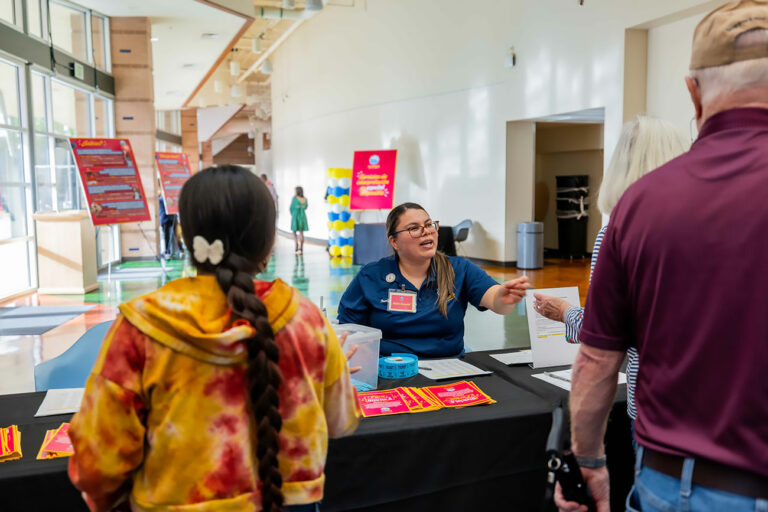
Become a member of our Parents Advocacy Group to connect with other families and drive grassroots change from the ground up.

Join Futuro San Antonio’s Policy Roundtable to help shape education policy in ways that reflect the needs and aspirations of our community.
Get the Full Report
Voices for Education Community Canvassing Campaign 2025
Dig into the data and learn more about how your District ranks for education in San Antonio.
RSVP to our Education Champions Roundtable
Pull up a seat! Join us for this hands-on conversation about the future of Education in San Antonio.
